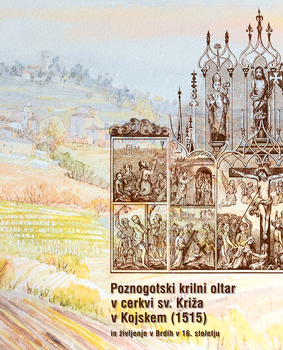Poznogotski krilni oltar v cerkvi sv. Križa v Kojskem (1515) in življenje v Brdih v 16. stoletju
The scientific monograph (' Late Gothic winged altar of St. Cross of Kojsko (1515) and life in the Brda region of the 16th century') is dedicated to the 500 th anniversary of the unique late Gothic winged altar which dates back to 1515. The anniversary has offered numerous opportunities to illuminate the importance of this medieval cultural monument, which boasts not only Goriška Brda, but all Slovenia. Individual contributions in the book deal with the broader historical and social context of life in the Brda region of the 16th century.
As it was pointed out by the historian of art Gašper Cerkovnik, the altar belongs to "the most important monuments of the Slovenian medieval period as it is the last example of the preserved ambitious winged altar and an important witness of the role the Carinthian art centres had for the Slovenian lands of that period" or how in its article pointed out the general conservator of the Institute for Protection for Cultural Heritage of Slovenia Rober Peskar, "the church of St. Cross presents a significant result of the development of architecture of the 15th century in the Goriška region, its bell tower being one of the oldest in this area and as such an example for the younger versions around." The contribution of the historian Tanja Gomiršek analyzes the ownership relations and economic changes on the basis of the census of souls from 1566 and the land register from the years 1565 to 1568 and presents socio-demographic picture of the villages of Kojsko and Brestje in the 16th century. The contribution of the historian Neva Makuc exposes the war situation from the first (1508-1516 / 1521) and the second (1615-1617) Austrian-Venetian wars in which the Brda played the role of strategically important areas along the Habsburg-Venetian border, and its peasant population of that time played an important role as the defenders of certain fortifications among which also the fortification of the village of Šmartno played a strategically significant role. The contribution of the conservator Andrejka Ščukovt deals with Šmartno, the already mentioned fortified "settlement monument" of exceptional historical and cultural value. The ethnological study of Katarina Štrimpf deals with the clothing culture in the Brda hills in the 16th century based on the literature review of the ways of dressing in the wider Goriška region. In this way, the circumstances of the foundation of the altar are placed in a broader historical context of the area, which is also discussed in terms of economic, military, administrative and cultural history.
Downloads

Series
License

This work is licensed under a Creative Commons Attribution-NonCommercial-NoDerivatives 4.0 International License.
